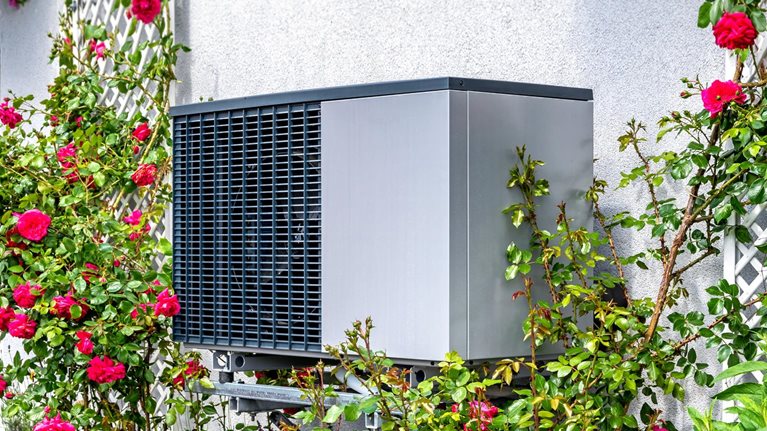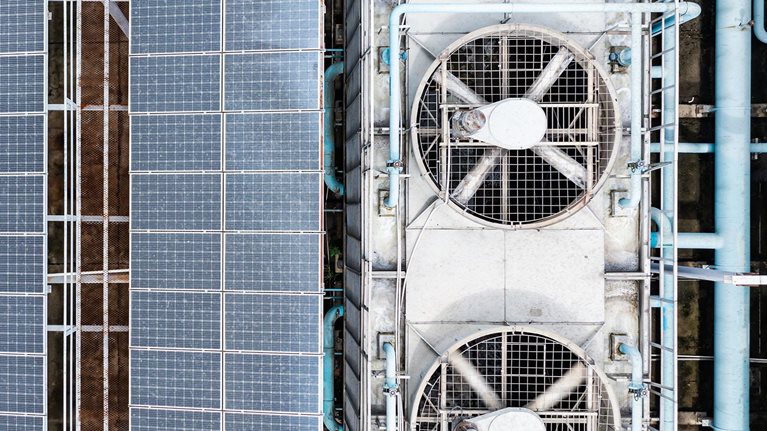Industrial heat pumps—heat pumps with power sizes beyond 200 kilowatts thermal (kWth)—have a critical role to play in the energy transition. Heat pumps use electricity instead of coal or gas as their fuel source. They thus have the potential to be powered by completely renewable energy. Heat pumps are also highly technologically effective. They are three to five times more efficient at low and medium temperatures than traditional boilers, allowing for reduced energy use, cost, and emissions.1 Although this is not a new technology, the technological edge of industrial heat pumps is beginning to be recognized more broadly. Recent trends, such as the push for the decarbonization and electrification of heat, economic factors, and government support through regulation and incentives mean that the market for industrial heat pumps is set to skyrocket, with expected growth of more than 15 percent per annum until 2030.
Early market entry is key for success in this race. However, some technologies, such as high-temperature industrial heat pumps, are still maturing. As demand grows across the industrial sector and district heating, OEMs that manufacture and install these heat pumps will need to develop new offerings.
We have identified five underdiscussed aspects of industrial heat pumps to consider when developing new heat pump offerings: the needs of different end users, heat pump components, refrigerant requirements, opportunities for heating and cooling, and approaches for creating new solutions. By being informed about and exploring these areas, heat pump OEMs and their customers will be better equipped to start conversations and collaborate to achieve technological advancements, grow the market, and help the world decarbonize.
Market dynamics today and in the future
For the industrial sector to meet decarbonization targets, it needs to address its heating-related fuel consumption and emissions. The industrial sector accounts for one-third of global CO2 emissions; out of those emissions, about two-thirds are used for heating.2 Consequently, industrial heating accounts for more than 20 percent of total global CO2 emissions. This is because industrial process heating is still largely fossil-based, with more than 85 percent of energy for heating provided by natural gas, coal, and oil boilers, compared with about 10 percent from biomass.3
Despite their economic advantages and ability to abate emissions, heat pumps today are still rather underrepresented, supplying only about 5 percent of global industrial heat. However, they hold great potential for industry. Industrial heat pumps use electricity and low-temperature heat from a primary source, such as seawater, sewage water, and excess heat, to efficiently provide heat energy for buildings and industrial processes. They can provide three to five4 times more heat energy per unit of electricity consumed than traditional heaters. Industrial heat pumps can also provide heat at higher temperature ranges than residential heat pumps can—in some cases up to 200ºC—as well as at capacities beyond ten thermal megawatts (MWth, equal to roughly 1,000 times the scale of heat pumps deployed in households, assuming a ten-kWth average). Because of their high efficiency, heat pumps can be more cost-effective than traditional heating, particularly in environments with high or volatile gas prices.
As the world decarbonizes, industrial heat pumps can be applied to a range of use cases. The food and beverage, pulp and paper, and chemical industries are particularly well-suited for heat pump use because of their high energy demands. These industries also have relatively high energy-related emissions (approximately 15 percent of global energy-related industrial CO2 emissions according to McKinsey analysis), which heat pumps could help abate. Heat pumps could also play an important role in district heating. This sector accounts for approximately 1 percent of total CO2 emissions, with a fuel mix that is more than 90 percent fossil-based today. District heating is most relevant in China and Russia as well as multiple European countries (Austria, Denmark, Finland, France, Germany, Italy, Norway, Poland, Sweden, and Ukraine). Low-cost conventional heat has led to a high fossil-fuel share of 65 percent in district heating in the European Union, which is even higher in some countries, such as Germany and Poland, where the fossil-fuel share for district heating stands at more than 80 percent. This fossil-heavy fuel mix means that heat pumps offer strong abatement potential for district heating, and a number of decarbonization projects with industrial heat pumps in district heating have recently been announced.
Thanks to their abatement potential and increasingly favorable economics, industrial heat pumps are expected to experience strong economic growth this decade (Exhibit 1). Governments are increasingly issuing regulations and support for heat decarbonization in industry and district heating. Meanwhile, companies are pledging net-zero targets and are looking for ways to decarbonize their energy use, specifically their heat supply.

As a result, globally, industrial heat pumps are expected to supply more than 10 percent of industrial and district heating demand at temperatures below 200°C by 2030. In the EU-27 plus the United Kingdom, the largest demand center for heat pumps today, heat pumps are expected to be responsible for about 15 percent of total district heating and 20 percent of industry heating processes for temperatures up to 200°C in 2030 (Exhibit 2). This is an increase of more than ten percentage points from 2023.

This growth will be fueled by significant investments. Global investments for industrial heat pumps are expected to reach $12 billion by 2030 in the Global Energy Perspective 2023’s Current Trajectory scenario,5 a fourfold increase from 2023 and a growth of more than 15 percent per annum. This could reach up to $21 billion in an Achieved Commitments scenario.6 Germany, France, the Nordics, Poland, and the United Kingdom are expected to be the first movers driving heat pump adoption in district heating and industry.
The trajectory of these investments is toward bigger installations. Today, the majority of investments in industrial heat pump installations go toward smaller and medium-size applications (up to five MWth) and temperatures from 80°C to 100°C because lower-temperature applications are more likely to provide a positive business case. However, large-scale industrial heat pumps (more than five MWth) with temperatures higher than 100°C are expected to become increasingly important in the future. District heating is also expected to remain an important segment for industrial heat pumps, at more than a third of the market in 2030.
Five considerations for the heat pump ecosystem
Industrial heat pumps are set to take off. Stronger adoption is expected in areas where industrial heat pumps are not a significant market today but are a feasible solution for process decarbonization, such as for food and beverages, pulp and paper, and district heating. Substantial investments are being made to reduce the carbon footprint of industrial organizations and district heating networks as they decarbonize and reduce their dependence on fossil fuels. As industrial heat pumps become deployed more widely, heat pump OEMs and end users in the industrial heat pump ecosystem will need to converse and collaborate.
Below, we provide five important topics that are underdiscussed today but will play important roles as industrial heat pump technology matures: varying requirements for industrial and district heating, component considerations, types of refrigerants, cooling opportunities for heat pumps, and collaborative structures to create solutions.
1. There is no one-size-fits-all solution for industrial and district heating
When it comes to industrial and district heating applications, there is no one-size-fits-all solution. Different applications have different specifications in terms of temperature, capacity, physical size, and integration into existing equipment. Large-scale heat pumps often have rigorous requirements for power output, utilization rates, and the temperature levels of heat sources and sinks. To meet the requirements of a given system, heat pumps may need to be customized or modified.
Industry. In industry, the temperature and capacity requirements of a given application determine whether heat pumps are a good fit (Exhibit 3). Small local breweries usually require temperatures from 50ºC to 120ºC at a capacity of less than one MWth, whereas chemical processes may need steam at more than 150°C and at well beyond a five-MWth capacity, a requirement that can be difficult to meet with existing heat pump solutions. Applications with less demanding specifications are expected to be able to employ “standard” heat pumps, which may include systems that are more economic and modular. Industries with more-intense heat requirements (for example, chemicals) may require more R&D for heat pumps to be applicable.

District heating. District heating (including pressurized water systems) typically requires temperatures ranging from 60ºC to about 135ºC, making it a good candidate for industrial heat pumps. At the same time, district heating needs to comply with existing infrastructure. Industrial heat pumps in district heating applications need to consider factors such as the size and temperature of the network. They also need to balance the heat supply mix to control energy volatility, such as by using several heat sources (for example, waste heat, waste incineration, and solar).
In both industrial and district heating applications, end users primarily focus on optimizing reliability and economics. For industrial end users specifically, the most important criterion is typically to minimize downtime to guarantee a continuous production process; the second most important is often to optimize the cost of heat.
For both industrial and district heating applications, tailoring the design and installation of large heat pump installations requires specialized knowledge and expertise. This can be an adoption barrier to heat pump OEMs, which have limited knowledge of use cases, and end users, which have limited knowledge of heat pump technology. For example, district heating providers usually have expertise with combined heat and power plants because district heating networks have historically been connected to coal- and gas-powered energy plants. However, district heating providers may have limited understanding of alternative energy options, including heat pumps. On the other side, OEMs that build very large heat pumps are often compressor manufacturers with dedicated knowledge in their field, but they may have limited knowledge about heat distribution and process integration for specific end user applications. By building a collaborative ecosystem, heat pump OEMs, industrial players, and district heating networks can share knowledge and reach more-sophisticated understandings of where and how best to deploy large-scale heat pumps.
2. A high-performing industrial heat pump is more than just a compressor
The performance of a heat pump is primarily determined by its compressor, heat exchangers (the condenser and evaporator), and control software. Of these, the compressor is often considered the most critical component. Compressors play a key role by determining the flow rate of the refrigerant and the efficiency of the compression process. In other words, they define how much heat energy can be packed into the refrigerant and thus to what degree the pump will be able to change temperature. Because of their complexity, compressors typically account for 20 percent to 35 percent of overall hardware capital expenditures in a given heat pump and carry significant intellectual property.
Despite this emphasis on compressors, other components of heat pumps play a crucial role in determining efficiency. Heat exchangers are well established as a technology and can be adapted and tailored to the needs of large heat pump applications. Recently, plate-and-shell heat exchangers have garnered attention, combining the efficiency and compactness of plate heat exchangers without gaskets.
Control software is also a critical component for industrial applications and shouldn’t be overlooked when designing new offerings. Unlike residential or commercial heat pumps, industrial heat pumps are bound with strict requirements for the coefficient of performance (COP). This is often tracked 24/7, and OEMs of industrial heat pumps can be penalized for not meeting COP requirements. Therefore, system control solutions and digital capabilities (including remote monitoring as well as preventive and predictive maintenance) are critical.
Overall, industrial heat pumps are built on solutions that have been applied for several decades, making them a rather mature technology. This means less cost decline is expected from moving forward on the learning curve. Nevertheless, with increasing application and scale in certain industries, modularization and standardization can help reduce hardware costs for critical components. Smart control and optimization can also help improve the operation, performance, and flexibility of industrial heat pumps, which can minimize operations and maintenance requirements and thus operating expenses.
3. The race is still on between natural and synthetic refrigerants
To find the optimal refrigerant for a given application, heat pump OEMs and end users must discuss the needs of a given project. Factors such as the required end temperature, regulations, and safety considerations all play into choosing the right refrigerant.
There are two groups of refrigerants: hydrofluorocarbons (HFCs) and hydrochlorofluorocarbons (HCFCs), and natural refrigerants. Some OEMs focus on only one group of refrigerants, whereas others have both groups in their portfolio (sometimes for historical reasons). While HFCs and HCFCs have been widely used in the past, there is a trend, especially in Europe, toward natural refrigerants because of (potential) environmental regulation, such as the F-gas quota limiting the use of fluorinated refrigerants with high global warming potentials (GWPs).
However, natural refrigerants come with their own considerations. Propane, isobutane, and isopentane can be highly flammable, a trait that requires specific safety measures. Thermodynamically, they have similar properties to HFCs and HCFCs, so they may be appropriate for many applications, including direct steam production for temperatures less than 150°C. Ammonia, which is widely used for refrigeration applications, is toxic, but it allows for very efficient thermodynamic cycles with zero ozone depletion or global warming potential. CO2 typically requires a transcritical cycle with high pressures and is best suited for applications where large temperature increases are needed. CO2 gains attractiveness in refrigeration as well as heating applications because it is nontoxic, nonflammable, and nonfluorinated. Water is an interesting refrigerant for high-temperature applications (steam compression), but evaporation must be run in vacuum for source temperatures below 100°C. Today, these and other alternative refrigerants are being researched and subsidized.
4. The most attractive use case combines heating and cooling demand
Perhaps because of their name, heat pumps are less known for their ability to provide cooling in addition to heating. In fact, a single device can provide both services, and combined applications lead to optimal business cases.
End users can assess whether it would be useful to have unified systems for heating and cooling. For example, in the food and beverage industry, breweries require heating and cooling during production and can use heat pumps for both. Seasons also provide a reason to integrate cooling into heat pump offerings. Office buildings can use the same industrial heat pump for heating in the winter and cooling in the summer, reducing the needed capital expenditures for a given building and maximizing utilization of the primary heat sink and source.
Combining heating and cooling applications can create synergies between different end users, such as by linking data centers to district heating networks. In these systems, heat pumps can cool data centers and upcycle the waste heat into district heating networks. The impact of the heat pump doubles by cycling heat energy in a way that is useful to both systems.
Similarly, combining industrial heat pumps with thermal storage systems can help stabilize the power grid as renewable energy sources such as wind power increase the volatility of power supplies. With a thermal-storage system, heat pumps can store excess energy by simply heating up storage systems. Thermal-storage systems (such as water tanks) are also cheap compared with storing electric energy in batteries. By coupling these systems with heat pumps, district heating can turn into a source of backup energy for electric networks. Overall, decoupling supply and demand can also lower electricity prices in times of high electricity demand.
5. OEMs, end users, and engineering, procurement, and construction firms need to collaborate to create the best solutions
In this period of growth, the industrial heat pump industry has work to do to expand its portfolio of product offerings. Overall, parties across the ecosystem can combine knowledge to develop the best solutions for given applications:
- OEMs. OEMs need to find the optimal balance between standardization and modularization to be able to provide tailored solutions at competitive prices. This requires deep knowledge of industrial processes and system solution capabilities such as heat source extraction and grid connection. Furthermore, continued R&D with an emphasis on design to value can help unlock applications at high powers and temperatures and improve environmental impact of technologies such as advanced low-GWP refrigerants, all while keeping costs down.
- End users. The full potential of heat pumps in terms of temperature and capacity ranges is not yet common knowledge among end users. When initiating discussions with potential end users, OEMs can help build their knowledge about the possibilities and boundaries of heat pump technology. In this early phase of technological development, these conversations can create win–win situations in which engineers can cocreate solutions with end users for different applications, including industrial and district heating use cases.
- Engineering, procurement, and construction (EPC). Thanks to their installation expertise, EPC firms may play a crucial role in facilitating the development and integration of tailored offerings. EPCs have detailed knowledge of the processes and setups of heat pumps, together with long-term, trusting relationships with end users and experience managing large-scale technical projects.
Strong partnerships between all three parties may help to accelerate heat pump adoption. This includes exploring new sales models suited to the preferences, knowledge, and requirements of particular customer groups. Customers may prefer to purchase off-the-shelf solutions; coordinate and develop new offerings with different stakeholders, including OEMs, EPCs, and utility providers; or even sign up for leasing or rental models. These sales models can also integrate subsequent maintenance and support.
Industrial heat pumps offer a compelling solution for industries looking to optimize their energy usage, reduce their costs and dependence on fossil-fuels, comply with environmental regulations, and enhance their overall operational efficiency. To capture this opportunity, companies should act now in strong collaboration with OEMs and EPCs to assess the feasibility of integrating heat pumps into existing systems or processes.


